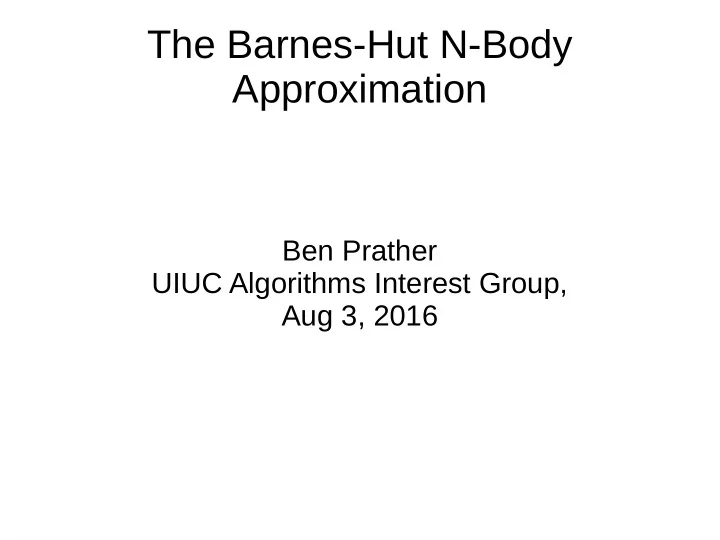

The Barnes-Hut N-Body Approximation Ben Prather UIUC Algorithms Interest Group, Aug 3, 2016
Why Newtonian N-Body? ● For some important problems, GR is not a significant correction – Finite speed of gravity is not relevant – Bodies all have v << c, no gravitational waves – Curvature of space is small – Universal expansion can be added manually ● GR-based calculations become difficult for many- body interactions ● Can be coupled with fluid dynamics simulations, or field approaches (particle in cell) ● Also useful for Björk concerts
Problem: N-Body Simulation ● Compute accelerations of N bodies, each by summing the influence of the N-1 other bodies ● Each step is thus ½ * N * (N-1) ~ O(N 2 ) operations – But to realize ½ improvement adds ¼ * N * (N-1) memory requirement ● Time-domain advance via Euler, explicit RK, leapfrog, etc, etc.
Why optimize? ● A galaxy contains ~10 11 stars ● Blue Waters is ~10 Pflops = 10 13 operations/sec ● At O(N 2 ): ~10 22 operations – Step takes 10 9 seconds or ~30 years ● At O(N log(n)): ~10 12 operations – Step takes 0.1 seconds!* *Restrictions apply. See caveats later.
Barnes-Hut Overview ● Far-away masses pull in roughly the same direction ● Why not consolidate them into one? ≅ ● Group by “cells.” Keep track of the center of mass and total mass of each cell ● Then, if a cell is small “enough” to consolidate, we can look up its CM and avoid touching all its children
Building the tree ● Add bodies to cells recursively to build a tree ● To add a body: – Start by adding the body to the root cell – Add the body to the cell’s CM and mass – If the cell already encloses a body: ● If the cell has no children, add them and propagate the body it currently encloses ● Add the new body to the appropriate child and repeat if it is occupied ● Thus, there will be O(N) leaf cells always have one body at most, and a tree of larger cells ● Complexity is O(log N) per body, total O(N log(N))
2D Tree Example Images: Barnes & Hut
2D Tree in Memory
3D Tree
Step Algorithm ● To compute influence on a body: – Recursively walk the tree, summing the effect of child cells to obtain the effect of larger cells – When the diameter of the cell becomes less than a certain factor of its distance away, disregard its children and use its COM and mass – The total influence is the acceleration due to the root cell ● Only O(log N) cells have radii large enough to be summed
Step Algorithm: Details ● From the original paper (in LISP): (define (acceleration particle ensemble) (cond ((singleton? ensemble) (newton-accel particle (the-element ensemble))) ((< (/ (diameter ensemble) (distance particle (centroid ensemble))) theta) (newton-accel particle (centroid ensemble))) (else (reduce sum-vector (map (lambda (e) (acceleration particle e)) (subdivisions ensemble))))))
Step Algorithm: Translation ● Perhaps more readable: def find_accel(self, body, cell): “”””Finds the gravitational effect on ‘body’ of whatever is inside ‘cell’””” if (cell.children is None) or (cell.diameter / norm(body.pos - cell.COM) < self.theta): return self.newton_accel(body, cell.COM, cell.mass) else: return sum([self.find_accel(body, child) for child in cell.children])
Step Example ● Red squares are added just as N 2 algorithm would ● Green square uses COM of three bodies since diameter is smaller than distance as shown ● Further squares lump more space together into groups of similar subtended angle
O(log(N)) Boxes are Counted ● Each “ring” of 12 boxes triples the area covered ● Thus N operations covers C*3 N/12 units of area ● So necessary operations go as log 3 (N/12)~log(N) with area ● Similar effect in 3D
Parallelization Notes ● The tree-building half of the algorithm is difficult to efficiently parallelize – The tree cannot easily be accessed in parallel – The first N levels of the tree can be precomputed, and the construction of the rest of the tree passed to 8 N threads ● However, resulting cells can be very unbalanced ● The rest of the algorithm, however, just needs to read the tree and update the locations, which are independent and thus easy to parallelize
Parallel Version ● Construct tree: – Split list of N particles among available processors, and compute lists of what resides in the first 8 m sub-trees – Dynamically load-balance the computation of each of the 8 m sub-trees across available threads – Merge sub-trees (m*8 m operations in 1 thread) ● Compute forces: – Trivially parallel if each thread has full tree access ● Tree takes O(N log(N)) memory! May have to be split – Otherwise request elements of others’ subtrees as necessary ● Update velocities/positions – Trivially parallel
Links ● Original Paper: – Barnes & Hut, “A hierarchical O(N log N) force-calculation algorithm,” – Nature 324, 446 - 449 (04 December 1986); doi:10.1038/324446a0 http://www.nature.com/nature/journal/v324/n6096/abs/324446a0.html – ● Parallel examples: https://scala-blitz.github.io/home/documentation/examples//barneshut.html – http://ta.twi.tudelft.nl/PA/onderwijs/week13-14/Nbody.html – ● Gravitational interaction speed: https://arxiv.org/abs/gr-qc/9909087 – ● Notable N-body simulations: http://hipacc.ucsc.edu/Bolshoi/ – http://wwwmpa.mpa-garching.mpg.de/millennium/ – ● Björk concert: – “Dark Matter,” Bestival 2011 https://www.youtube.com/watch?v=dkagu0qWBio –
Recommend
More recommend